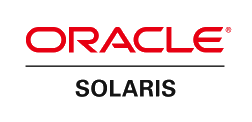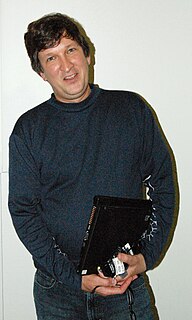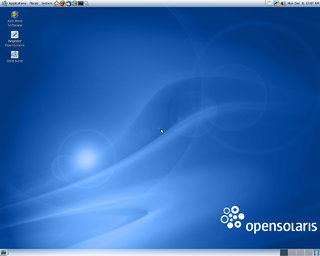Sun WorkShop TeamWare (later Forte TeamWare, then Forte Code Management Software) is a distributed source code revision control system made by Sun Microsystems. It was first announced in November 1992 as SPARCworks/TeamWare and ProWorks/TeamWare and made commercially available in 1993. [1] Last available as part of the Forte Developer 6 update 2 product, TeamWare is no longer being offered for sale, [2] and is not part of the Sun Studio product.
In computing, source code is any collection of code, possibly with comments, written using a human-readable programming language, usually as plain text. The source code of a program is specially designed to facilitate the work of computer programmers, who specify the actions to be performed by a computer mostly by writing source code. The source code is often transformed by an assembler or compiler into binary machine code understood by the computer. The machine code might then be stored for execution at a later time. Alternatively, source code may be interpreted and thus immediately executed.

Sun Microsystems, Inc. was an American company that sold computers, computer components, software, and information technology services and created the Java programming language, the Solaris operating system, ZFS, the Network File System (NFS), and SPARC. Sun contributed significantly to the evolution of several key computing technologies, among them Unix, RISC processors, thin client computing, and virtualized computing. Sun was founded on February 24, 1982. At its height, the Sun headquarters were in Santa Clara, California, on the former west campus of the Agnews Developmental Center.
TeamWare's largest deployment was inside Sun itself, where (bar a few exceptions) at one point it was the only VCS used. TeamWare had been used to manage Sun's largest source trees, including those for Solaris and Java, but as part of the process of converting those code bases to open source communities, they were moved to newer revision control systems such as Mercurial.

Solaris is a Unix operating system originally developed by Sun Microsystems. It superseded their earlier SunOS in 1993. In 2010, after the Sun acquisition by Oracle, it was renamed Oracle Solaris.

Java is a general-purpose programming language that is class-based, object-oriented, and designed to have as few implementation dependencies as possible. It is intended to let application developers write once, run anywhere (WORA), meaning that compiled Java code can run on all platforms that support Java without the need for recompilation. Java applications are typically compiled to bytecode that can run on any Java virtual machine (JVM) regardless of the underlying computer architecture. The syntax of Java is similar to C and C++, but it has fewer low-level facilities than either of them. As of 2019, Java was one of the most popular programming languages in use according to GitHub, particularly for client-server web applications, with a reported 9 million developers.
The open-source model is a decentralized software development model that encourages open collaboration. A main principle of open-source software development is peer production, with products such as source code, blueprints, and documentation freely available to the public. The open-source movement in software began as a response to the limitations of proprietary code. The model is used for projects such as in open-source appropriate technology, and open-source drug discovery.
TeamWare features a number of advanced features not found in earlier version control systems like RCS and CVS. In particular, it features a hierarchy of source repositories, and allows atomic updates of multiple files, features found in later version-control systems such as Subversion and Perforce. TeamWare allows distributed development by copying a repository to another which might reside on another machine or network. Developers can then commit changes to the local copy of the repository, periodically integrating accumulated changes in the local repository back into the original repository.
Revision Control System(RCS) is an early version control system (VCS). It is a set of UNIX commands that allow multiple users to develop and maintain program code or documents. With RCS, users can make their own revisions of a document, commit changes, and merge them. RCS was originally developed for programs but is also useful for text documents or configuration files that are frequently revised.
The Concurrent Versions System (CVS), also known as the Concurrent Versioning System, is a free client-server revision control system in the field of software development. A version control system keeps track of all work and all changes in a set of files, and allows several developers to collaborate. Dick Grune developed CVS as a series of shell scripts in July 1986.
Perforce, legally Perforce Software, Inc., is a Minneapolis, Minnesota-based developer of software used for application development, including version control software, web-based repository management, developer collaboration, application lifecycle management and Agile planning software. The software is sold under the Helix and Hansoft brand names.
TeamWare is implemented as a layer over the older SCCS, which is used to track changes to individual files. TeamWare works only by a system of files accessed by client programs (interacting without a server) and most distributed users of a repository access it by means of a mounted networked filesystem such as NFS.
Source Code Control System (SCCS) is a version control system designed to track changes in source code and other text files during the development of a piece of software. This allows the user to retrieve any of the previous versions of the original source code and the changes which are stored. It was originally developed at Bell Labs beginning in late 1972 by Marc Rochkind for an IBM System/370 computer running OS/360.

A client is a piece of computer hardware or software that accesses a service made available by a server. The server is often on another computer system, in which case the client accesses the service by way of a network.

In computing, a server is a computer program or a device that provides functionality for other programs or devices, called "clients". This architecture is called the client–server model, and a single overall computation is distributed across multiple processes or devices. Servers can provide various functionalities, often called "services", such as sharing data or resources among multiple clients, or performing computation for a client. A single server can serve multiple clients, and a single client can use multiple servers. A client process may run on the same device or may connect over a network to a server on a different device. Typical servers are database servers, file servers, mail servers, print servers, web servers, game servers, and application servers.
Evan Adams was the architectural lead for TeamWare. [3] Glenn Skinner was the inventor of smoosh [4] [ better source needed ][ discuss ] and Larry McVoy authored smoosh, a tool to merge SCCS files, [5] which is said to be a precursor to TeamWare. [6] The BitKeeper version control system, designed by McVoy, shares a number of design concepts with the earlier TeamWare.

Larry McVoy is the CEO of BitMover, the company that makes BitKeeper, a version control system that was used from February 2002 to early 2005 to manage the source code of the Linux kernel.
BitKeeper is a software tool for distributed revision control of computer source code. Originally proprietary software, it was released as open-source software under the Apache License 2.0 on 9 May 2016. BitKeeper is produced by BitMover Inc., a privately held company based in Los Gatos, California and owned by its CEO, Larry McVoy, who had previously designed TeamWare.




